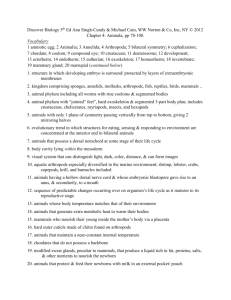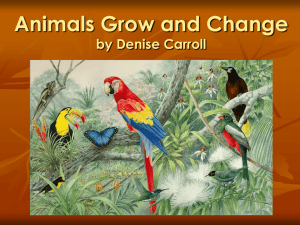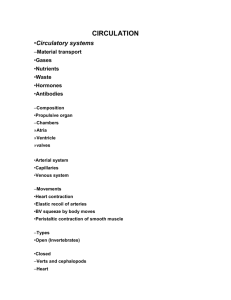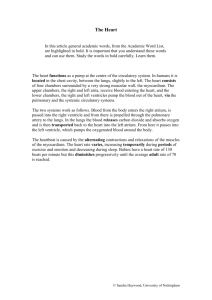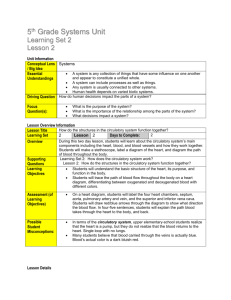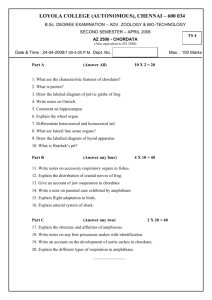Fishes, Amphibians, Birds, Reptiles, Mammals
advertisement
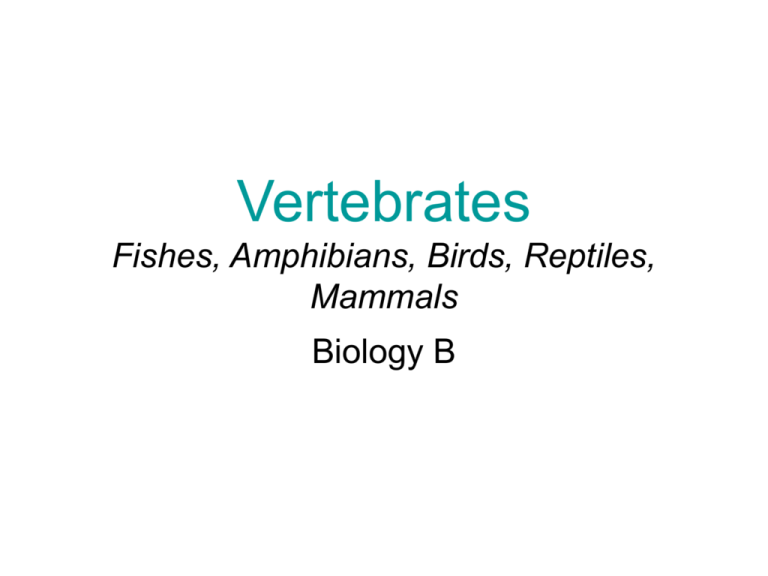
Vertebrates Fishes, Amphibians, Birds, Reptiles, Mammals Biology B Chordate Cladogram Section 30-1 Mammals Birds Amphibians Fishes Nonvertebrate chordates Invertebrate ancestor Reptiles Nonvertebrate Chorodate • Choradate – Dorsal hollow nerve cord – Notochord – Pharyngeal pouches – Tail that extend beyond anus • Nonvertebrate Chorodates – Tunicates and Lancelets The Generalized Structure of a Chordate Section 30-1 Notochord Muscle segments Tail Hollow nerve cord Anus Mouth Pharyngeal pouches b 3 Characteristics of all Vertebrates 1. Endoskeleton. Supports larger animal size. Grows with animal (No molting!) 2. Backbone and cephalization. Well-developed brain with sensory organs. Earliest vertebrates were called ostracoderms. 3. Closed circulatory system with multi-chambered heart. 3- or 4-chambered heart allows blood to be separated into oxygenated or deoxygenated. More efficient delivery of oxygen to the body. Endotherms and Ectotherms • Ectotherm: Temperature is regulated by external environment. – Fish, amphibians, reptiles • Endotherm: Body temperature is regulated by internal processes. – Mammals, birds Temperature Control in Chordates Body Temperature (°C) Section 33-2 Environmental Temperature (°C) Diversity of Chordates Section 33-1 • • • • Characteristics of Fishes Live in water. Overlapping scales that cover skin. Mucus coat (reduces friction when swimming). Swim bladder (buoyancy, sharks don’t have one). – Why do many sharks never stop swimming? • Lateral line system (detects vibrations in water). • Gills (blood and water flow in opposite directions; more efficient oxygen absorbtion and CO2 release. OPERCULA: opening and closing flaps; sharks) The Anatomy of a Fish Section 30-2 Kidney Pyloric cecum Stomach Vertebra Muscle Esophagus Swim bladder Brain Spinal Gills cord Mouth Operculum Urinary bladder Heart Anus Reproductive organ Pancreas Intestine Gallbladder Liver Circulation in a Fish Section 30-2 Gills Body muscle circulation Digestive system circulation Heart Oxygen-rich blood Oxygen-poor blood Brain and head circulation Sinus Venosus Oxygen-poor blood from the veins collects in the sinus venosus. Ventricle The ventricle pumps blood into the bulbus arteriosus. Atrium Blood enters the atrium and flows to the ventricle. Bulbus Arteriosus The bulbus arteriosus moves blood into the ventral aorta and toward the gills. Fish: Life Cycle • Varied strategies. – Sharks: internal fertilization. Salmon: external. • Generally, lay many more eggs than they need. – Many are never fertilized. – Many more are fertilized than the environment can support. (Why? Isn’t this wasted effort on the part of the fishes?) Rainbow Cut Throat Characteristics of Amphibians • Live both in water and on land. • Four strong limbs. • Nictating membrane: see through second eyelid. Why is this helpful on both land and in the water? • Tympanic membrane: hearing. Land? Water? Amphibians: Energy and Wastes • A frog’s skin “breathes” – it must be kept moist. • 3-Chambered Heart, Double-looped circulatory system. – What is that? Why is that a good thing? • Metamorphisis: teeth/jaws, gills turn into lungs, circulatory system changes • Kidneys regulate the amount of water in the frog. – In water excrete, on land retain. The Life Cycle of a Frog Section 30-3 Adult Frog Young Frog Adults are typically ready to breed in about one to two years. Frog eggs are laid in water and undergo external fertilization. Fertilized Eggs The eggs hatch into tadpoles a few days to several weeks later. Tadpoles Tadpoles gradually grow limbs, lose their tails and gills, and become meat-eaters as they develop into terrestrial adults. Characteristics of Reptiles • Dry, scaly skin (prevents evaporation). – Keratin: A hard, water-resistant protein (human hair and fingernails, bird feathers). • Usually carnivores. • Separated 3-chambered heart (crocodiles have 4 chambers). • Ectotherms. – How does a reptile regulate its body temperature? Rafekie The Amniotic Egg (Figure 26.4) • • • • • Embryo: connected to Yolk by a stalk. Yolk: food source. Amnion: fluid that protects the embryo. Chorion: regulates gas exchange. Shell: Waterproofs, protects. The shell is porous (gas can exchange through it). • Allantois: stores wastes. The Amniotic Egg Section 31-1 Amnion The amnion is a fluid-filled sac that surrounds and cushions the developing embryo. It produces a protected, watery environment. Allantois The allantois stores the waste produced by the embryo. It also serves as a respiratory organ. Embryo Chorion The chorion regulates the transport of oxygen from the surface of the egg to the embryo and the transport of carbon dioxide, one product of respiration, in the opposite direction. Yolk sac This baglike structure contains a yolk that serves as a nutrient-rich food supply for the embryo. Shell Characteristics of Birds • Adaptations center around flight… – Light-weight bones: hollow, but have cross braces. – Shape of a bird’s wings gives lift. – Fused bones (ligaments are heavy). – Massive flight muscles (Pectoralis: 25% of weight). • Shape of the wings gives lift. • The one reptilian characteristic of birds is their scale-covered legs. The Digestive System of a Pigeon Section 31-2 Brain Esophagus 1 When a bird eats, food moves down the esophagus and is stored in the crop. Lung Heart Kidney Crop Air sac 2 Moistened food passes to the stomach, a two-part chamber. The first chamber secretes acid and enzymes. The partially digested food moves to the second chamber, the gizzard. Liver First chamber of stomach Gizzard Small intestine 3 The muscular walls of the gizzard squeeze the contents, while small stones grind the food. Pancreas Large intestine Cloaca 5 Undigested food is excreted through the cloaca. 4 As digestion continues, the food moves through the intestines. You Eat Like A Bird… • Endotherms – requires a lot of energy to maintain their high metabolism. • Feathers – trap body heat. • Unique respiratory system – air flows one-way. • Crop Gizzard Intestines. – Figure 26.18. Blue Jay- Mr. Phillips Favorite Bird • Toronto Blue Jays World Series 19921993 Champions Characteristics of Mammals • • • • Endotherms – hair. Mammary glands – produce milk. Large, well-developed brains. 4-chambered heart, double-looped circulatory system. Variety of Mammals • Size – Smallest: shrew (weighs less than a dime) – Largest: whale (100,000 kg; 32 elephants) • Speed – Slowest: Two-toed sloth (1 meter/15 seconds) – Fastest: Cheetah (400 meters/15 seconds) – Humans (150 meters/15 seconds) • Environments Mammals: Movement and Energy • High-speed running: long bones and flexible hip and shoulder joints. • Eat a variety of foods: different teeth structures. • Diaphram: More gas exchange. • Air sacs: increased surface area for gas exchange. The Jaws and Teeth of Mammals Section 32-1 CARNIVORE Canines are pointed teeth. Carnivores use them for piercing, gripping, and tearing. In herbivores, they are reduced or absent. HERBIVORE Jaw joint Jaw joint Wolf Horse Chisel-like incisors are used for cutting, gnawing, and grooming. Molars crush and grind food. The ridged shape of the wolf’s molars and premolars allows them to interlock during chewing, like the blades of scissors. The broad, flattened molars and premolars of horses are adapted for grinding tough plants. Mammals: Types of Life Cycles • Monotremes: Reproduce by laying eggs (duck-billed playtpus).• Marsupials: Give birth to small, immature young that then further develop inside the mother’s external pouch (kangaroo). • Placental mammals: Babies develop inside the mother’s body (95% of all mammals). Section 39-4 The Placenta The Success of Mammals • Well-developed cerebrum: The largest part of the brain; makes processing information and learning possible. • Care of the Young: Development inside the mother; care of the young for the first year(s) of their life. Compare/Contrast Table Section 33-3 Comparing Functions of Chordates Function Nonvertebrate Chordates Fishes Amphibians (adult) Reptiles Birds Respiration Gills and diffusion Gills/air sacs Simple lungs and skin Lungs Lungs (tubes Lungs and air sacs; (alveoli) one-way flow) Circulation No true chambers Single loop; 2 Double loop; chambers 3 chambers Double loop; 3 chambers Double loop; 4 chambers Double loop; 4 chambers Excretion Gills and gill slits Kidney and gills Kidney Kidney Kidney Response Simple; mass Cephalization; Cephalization; Cephalization; Cephalization; Cephalization; of nerve cells small small small large large cerebrum cerebrum cerebrum cerebrum cerebrum Kidney and gills Mammals The Circulatory Systems of Vertebrates Section 33-3 Single-Loop Circulatory System FISHES Double-Loop Circulatory System MOST REPTILES CROCODILIANS, BIRDS, AND MAMMALS Compare/Contrast Table continued Section 33-3 Comparing Functions of Chordates Fishes Amphibians Amphibians (adult) (adult) Reptiles Birds Mammals Muscles on either side of backbone Limbs stick out sideways; muscles and ligaments Limbs point directly toward ground; muscles and ligaments Upper limbs are wings; 2 feet; muscles and ligaments 2 or 4 legs; walk with legs straight under them; muscles and ligaments Reproduction External fertilization External fertilization External fertilization Internal fertilization; shelled egg Internal fertilization; shelled egg Internal fertilization and development Temperature Ectothermic Control Ectothermic Ectothermic Ectothermic Endothermic Endothermic Function Movement Nonvertebrate Chordates Muscles, no bones The Digestive Systems of Vertebrates Section 33-3 Esophagus Stomach Intestine Liver Gallbladder Pancreas Cloaca Crop Gizzard Cecum Rectum Shark Salamander Lizard Pigeon Cow Figure 35-2 Human Organ Systems Part I Section 35-1 Nervous System Integumentary System Skeletal System Muscular System Circulatory System Figure 35-8 The Synapse Section 35-2 Direction of Impulse Dendrite of adjacent neuron Axon Vesicle Receptor Axon terminal Synaptic cleft Neurotransmitter Figure 35-9 The Brain Section 35-3 Cerebrum Thalamus Pineal gland Hypothalamus Cerebellum Pituitary gland Pons Medulla oblongata Spinal cord The Senses of Smell and Taste Section 35-4 Olfactory (smell) bulb Taste sensory area Olfactory nerve Thalamus Cerebral cortex Smell receptor Nasal cavity Smell sensory area Taste bud Taste pore Taste receptor Sensory nerve fibers Figure 35-14 The Eye Section 35-4 Vitreous humor Muscle Lens Fovea Aqueous humor Cornea Pupil Optic nerve Iris Blood vessels Ligaments Retina Choroid Sclera Figure 35-15 The Ear Section 35-4 Anvil Stirrup Hammer Oval window Semicircular canals Cochlear nerve Cochlea Bone Auditory canal Tympanum Round window Eustachian tube The Skeletal System Section 36-1 Skull Axial Skeleton Clavicle Sternum Ribs Vertebral column Scapula Humerus Radius Pelvis Ulna Carpals Metacarpals Phalanges Femur Patella Fibula Tibia Tarsals Metatarsals Phalanges Appendicular Skeleton Figure 36-7 Skeletal Muscle Structure Section 36-2 Figure 36-13 The Structure of Skin Section 36-3 Section 37-1 Figure 37-2 The Circulatory System Capillaries of head and arms Superior vena cava Pulmonary vein Capillaries of right lung Aorta Pulmonary artery Capillaries of left lung Inferior vena cava Capillaries of abdominal organs and legs Figure 37-3 The Structures of the Heart Section 37-1 Superior Vena Cava Large vein that brings oxygen-poor blood from the upper part of the body to the right atrium Aorta Brings oxygen-rich blood from the left ventricle to the rest of the body Pulmonary Arteries Bring oxygen-poor blood to the lungs Pulmonary Veins Bring oxygen-rich blood from each of the lungs to the left atrium Left Atrium Pulmonary Valve Prevents blood from flowing back into the right ventricle after it has entered the pulmonary artery Right Atrium Tricuspid Valve Prevents blood from flowing back into the right atrium after it has entered the right ventricle Aortic Valve Prevents blood from flowing back into the left ventricle after it has entered the aorta Mitral Valve Prevents blood from flowing back into the left atrium after it has entered the left ventricle Left Ventricle Inferior Vena Cava Vein that brings oxygen-poor blood from the lower part of the body to the right atrium Septum Right Ventricle Figure 37-13 The Respiratory System Section 37-3 Figure 37-15 The Mechanics of Breathing Section 37-3 Air exhaled Air inhaled Rib cage lowers Rib cage rises Diaphragm Diaphragm Inhalation Exhalation Figure 37-14 Gas Exchange in the Lungs Section 37-3 Alveoli Bronchiole Capillary The Digestive System Section 38-2 Mouth Pharynx Salivary glands Esophagus Liver Gallbladder (behind liver) Stomach Pancreas (behind stomach) Large intestine Small intestine Rectum The Small Intestine Section 38-2 Villus Small Intestine Circular folds Epithelial cells Villi Capillaries Lacteal Vein Artery Section 39-3 The Male Reproductive System The Female Reproductive System Section 39-3 Figure 35-2 Human Organ Systems Part 2 Section 35-1 Respiratory System Endocrine System Digestive System Reproductive System Excretory System Lymphatic/Immune Systems
